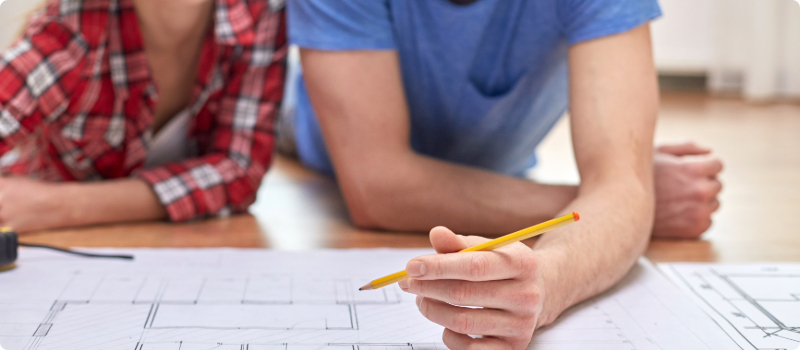Preparing to buy a pool
Updated June 25, 2024 . AmFam Team
Had enough of the massive crowds at your public pool? Maybe you’re considering installing your own. Before you dive in headfirst, we’ll be your lifeguard and share some ground rules for making your big purchase.

Pool safety
The most important thing to consider when building a pool is the safety of those who will use it. Safety is particularly important for families with children or pets. Put a fence around the deck or pool entry area to protect anyone from falling in.
If you’re building an in-ground pool, work with your builder to ensure that all possible safety features are being installed. Appropriate depth markers, first aid stations and flotation devices should be easily accessed from the pool area.
Budgeting for a new pool
Before making calls and visiting showrooms, you need to know how much you can afford to spend. Your budget will inform many aspects of your purchase, such as the type of pool, the material it’s made of, its size and more. An in-ground pool can cost tens of thousands of dollars, while above-ground models can be more affordable. Don’t forget the maintenance costs of a pool, which can run into the thousands if major problems need to be addressed.
Your insurance policy will likely change as a result of owning a pool, too. Before you start digging, talk with your American Family Insurance agent, as you could be adding monthly expenses that you may not have planned for.
Types of swimming pools
The kind of pool you’re going to get doesn’t just depend on your budget — it depends on your space, what you plan to use it for, and your desired timeline for its installation. Consider the following benefits, drawbacks and features of the different types of pools before you decide:
Above-ground pool. The best thing about an above-ground pool? The cost. Plus, you’ll avoid a lengthy installation that will include digging up your lawn. Another benefit is the added safety of an above-ground pool’s higher walls. And if you eventually tire of your pool, its removal is much easier.
They don’t come without their issues, though. For some, these pools aren’t as visually appealing. The sides are exposed to open air and debris, and they can be less durable. If you’re looking to get a pool for exercise, an above-ground model likely won’t have enough space for you to swim laps.
In-ground pools. While much more expensive, in-ground pools can be paired with intricate landscaping and lush greenery that looks great and can even boost the value of your home. Add a diving board and other pool accessories and you'll have a party pad primed to sell. Your pool deck can also serve as an excellent place to relax — and if your pool is large enough, you can use it for exercise.
Before purchasing a pool, consider the time and money you’re able to invest in it. How long are you planning to remain in your home? If you’re looking to sell in the near future, installing a pool might not be your best option since some buyers might not be interested in a home with a pool.

Before building your pool
Prior to purchasing a pool, here are a handful of elements you need to consider:
Building codes. Make sure you’re able to build a pool in your backyard — things could get awfully expensive, awkward and embarrassing if you try to build a pool where you legally cannot. You may be subject to building codes or homeowner’s association rules, so contact your local municipality to make sure you’ve taken all the necessary steps.
Weather. Consider the weather’s effect on your soon-to-be-constructed pool. Colder climates will necessitate a pool heater, while areas with lots of wind will require a cover to keep leaves, sticks and other debris out of your pool. If your climate includes cold winter weather, be prepared to drain your pool and protect the structure during those months.
Location. Does your backyard have the space for a pool? Will there be any yard left after you’ve installed it? Keep in mind that an in-ground pool can’t be removed or filled in without incurring tremendous costs, so make sure you’re comfortable giving up a large portion of your greens pace.
Use of the pool. What’s your main reason for building a pool in the first place? Is it for your kids? Will it be the hub for neighborhood get-togethers? Different uses will require different features — discuss its future uses with your contractor to design a pool that fits your needs.
Cleaning. Are you prepared to clean your pool manually, or are you willing to spend some extra cash on top-of-the-line filters and an automated cleaning system? Think about how much effort you want to put into keeping your pool healthy and clean before you build your pool.
Lighting. Do you plan on using your pool at night? Consider positioning it to receive as much natural light as possible. You can also install lights to make sure the pool, deck and surrounding area are safely visible during any evening swims.
Insurance. Protect your loved ones and what’s important to you by properly insuring yourself and your pool. Your American Insurance Family agent can tell you more about the additional coverages and policies you can add to your homeowner’s plan when considering a pool. Protect yourself from financial damages in the event you’re found liable for an accident with umbrella insurance, and look into increasing your liability limits, too.
After clearing all your pre-pool hurdles, shop around to find the best price, timeline and quality for your future pool. Ask for references from previous customers to get a better picture of a contractor’s work, and be upfront about how much you’re willing to spend.

Building your new pool
Above-ground pools can be purchased, constructed, and ready for use in a relatively short period of time. And if you’re a do-it-yourselfer, you might be able to put it together in a day’s time with some extra help.
In-ground pools, on the other hand, can take well over a month to install. Installation times will differ based on whether you choose a vinyl, fiberglass or concrete pool. Be prepared for some noise and mess during the construction, and as a courtesy, let your neighbors know they can expect some commotion for a few weeks.
Buying a pool is a big decision. And your American Family Insurance agent can help you prepare to keep it, and those who use it, safe and happy for the long run.
This article is for informational purposes only and includes information widely available through different sources. We believe this information is accurate but do not make any guarantees or promise any results based on this information. This article does not afford, offer, or guarantee any coverage.

